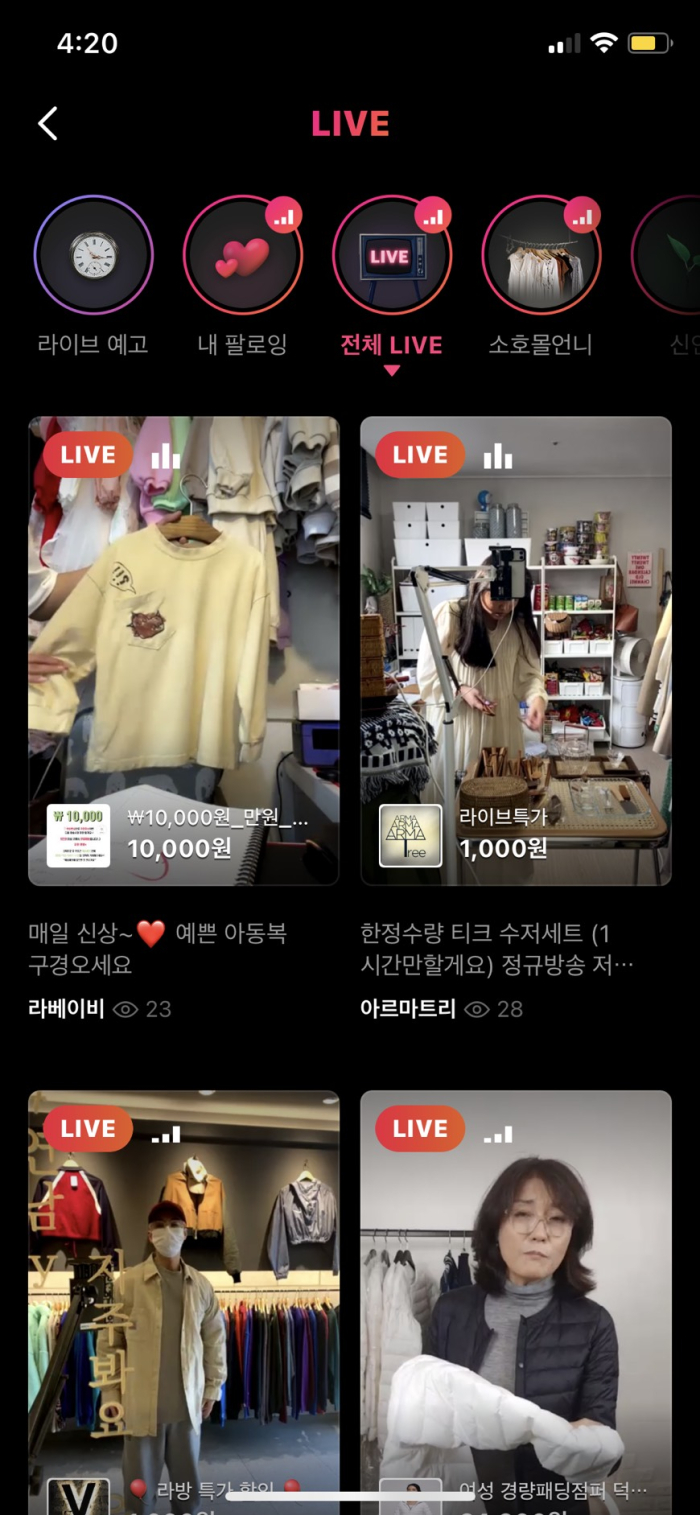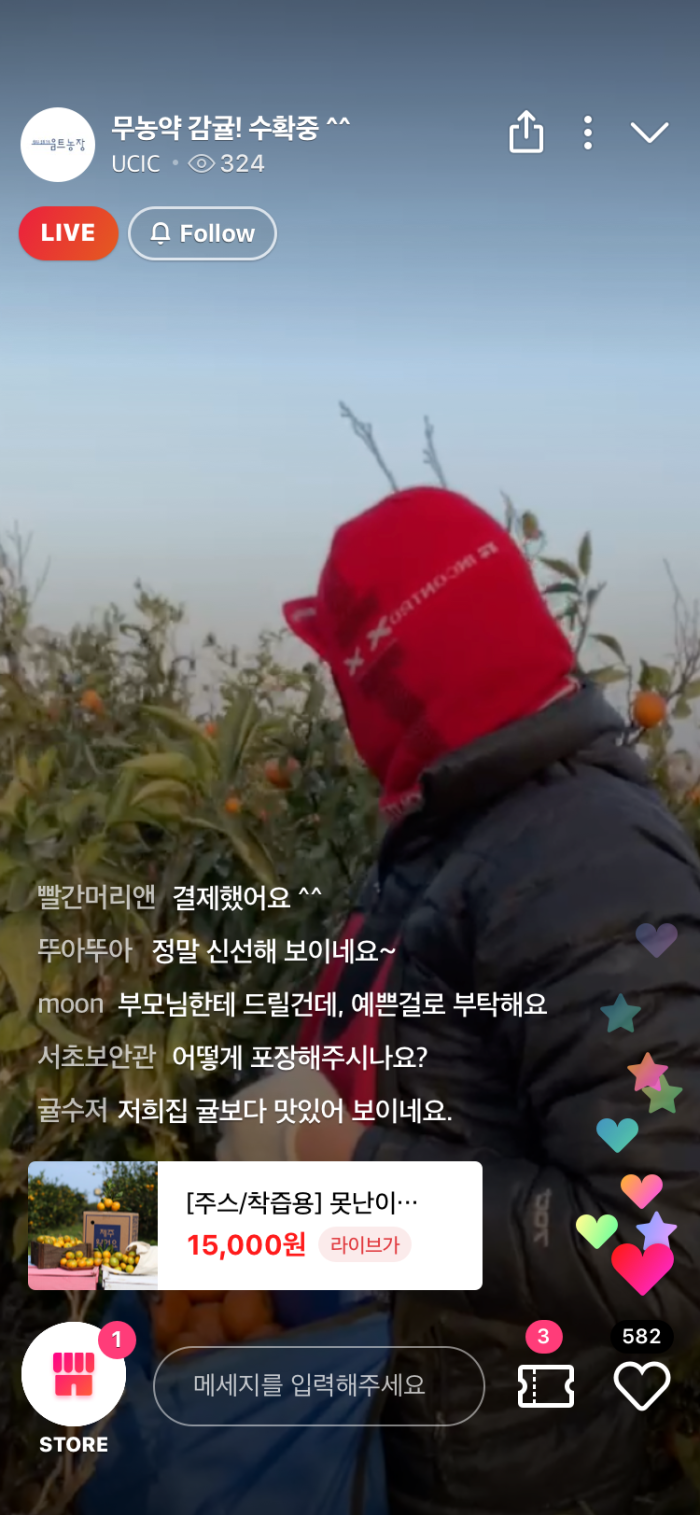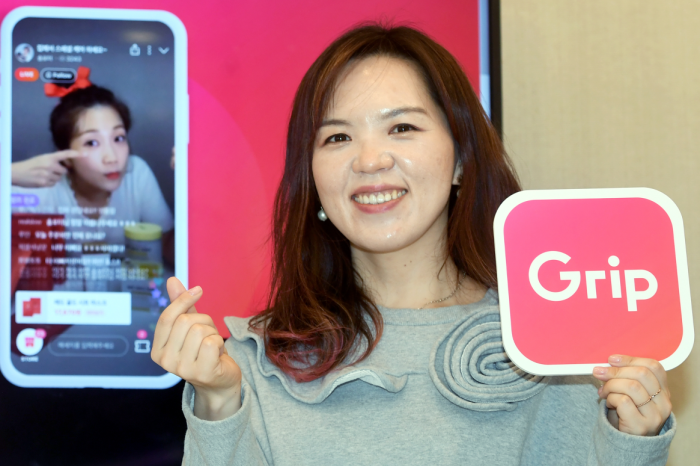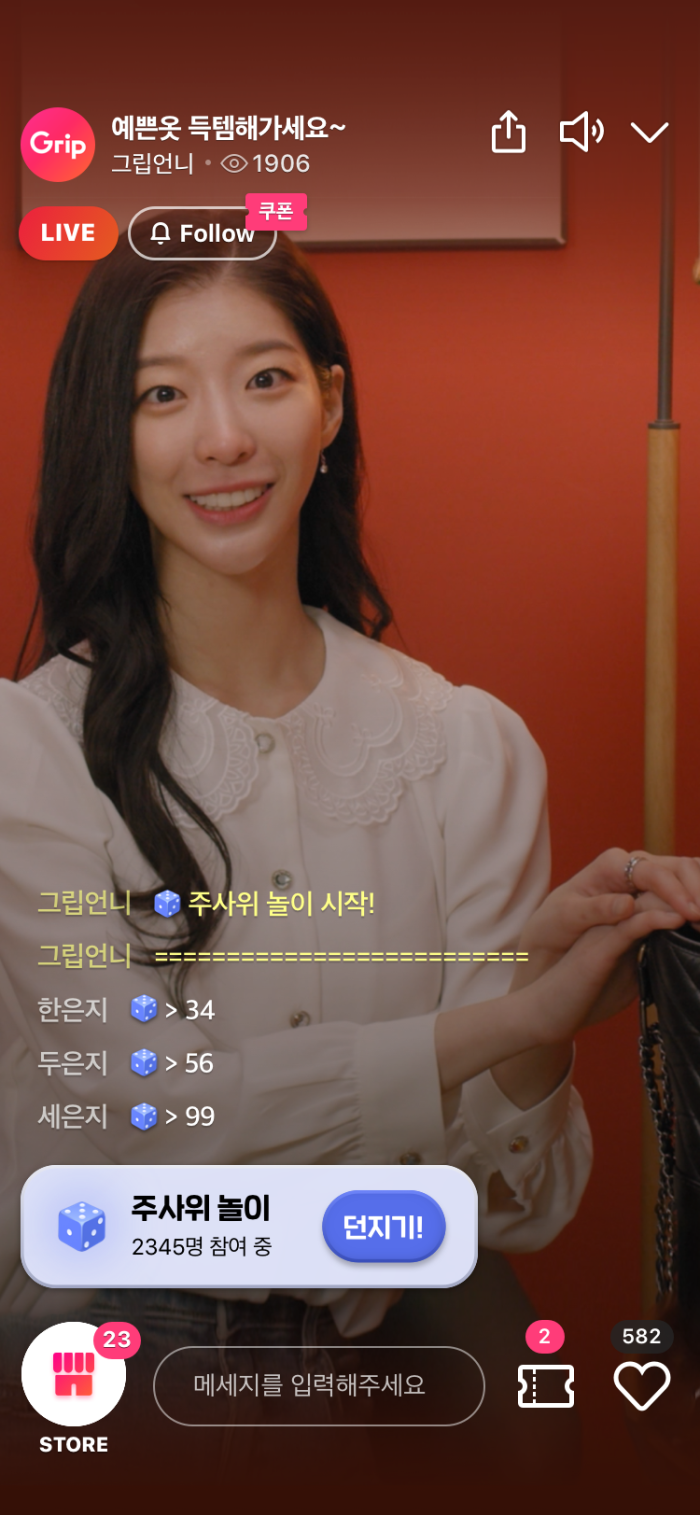-
KOSPI 2577.27 -2.21 -0.09%
-
KOSDAQ 722.52 -7.07 -0.97%
-
KOSPI200 341.49 +0.02 +0.01%
-
USD/KRW 1396 -2.00 0.14%
 Future Unicorns
Future Unicorns
Grip
Live commerce
Grip, a trailblazer in South Korea’s live commerce industry, offers a platform where vendors sell products to viewers via livestream. Grip’s creative, catchy content is the backbone of its unique community culture, which has become a hit among next-generation shoppers — millennials and Gen Zers alike. The app has been downloaded over 1.7 million times, boasting over 12,000 sellers on its platform. As of December 2020, the company has logged a cumulative transaction amount of 24 billion won ($21.5 million).
Published: 2021-04-19 17:17:40
Last updated: 2021-04-30 16:45:59
- Story
- Data
Grip: Envisioning a borderless live platform for sellers and buyers worldwide
How a video call led to South Korea's first live commerce app
“Hanna, look at this! Amazing right? It’s a whole new experience eating it here, where it comes from.”
This conversation took place in the summer of 2017, when Hanna Kim received a video call that would change her life. Kim’s friend was visiting Hoengseong, Gangwon-do, a region famous for South Korean beef, or Hanwoo, when she called Kim to show her the savory meat sizzling on the grill live through the video call.
“We hung up, but that image of Hanwoo stayed in my head for hours. I eventually decided to order it and searched for the restaurant, but it wasn’t easy and my friend had already left Hoengseong,” Kim recalled.
After spending hours looking at maps online, Kim finally found the restaurant and called to place an order for meat delivery. In the midst of it all, she kept thinking to herself: Why am I putting myself through this?
The answer was actually very clear. The video call triggered in Kim the desire to buy the Hanwoo, while also providing credibility and context. It suddenly occurred to her that if a convenient payment tool were added to the equation, it would be a great shopping platform. This was the moment that Kim came up with her live commerce business idea.
One year later, Kim formally established Grip in July 2018 and launched the service in February 2019 -- introducing South Korea’s first live commerce platform.
On Grip, people sell products via livestream. Some say that it’s basically transferring TV home shopping to a mobile platform, but that’s not what Kim thinks.
“Considering that it’s interactive communication between the seller and the user, it might be similar to adding a shopping feature to a video chat or spicing up a livestream by combining shopping with entertainment,” said Kim.
“It could even be considered educational content that delivers practical information. It’s definitely a new genre in e-commerce.”
Contents
Click to move to each section
- [Problem to solve?] Everyone can sell
- [Team building] Working with IT industry’s best of the best
- [Early growth strategy] Killer content creates network effect
- [Revenue model] Revenue model diversification strategy
- [Challenge] Domestic IT giants tap into live commerce
- [Scale-up] Securing investments and foraying abroad
[Problem to solve?] Everyone can sell
In recent decades, as the retail market rapidly transitioned online, certain groups were becoming more and more alienated, including seniors for whom the digital transition was just out of reach, or sellers in decentralized business districts. Kim saw how live commerce would address these issues.
With Grip, anyone can become an online seller simply by turning on a portable camera, and presenting a product as they would do for an offline customer. Further, they can access the digital commerce market without setting up a separate online shop.

“The digitally alienated population is much larger than we had imagined. I was sure we could build a company that could have a positive influence if we could draw some of these people into the digital world,” said Kim.
Kim firmly believes in the strong growth potential of the live commerce market. According to industry watchers, Korea’s live commerce market is expected to top 8 trillion won in 2023.
Kim says the greatest advantage of live commerce is its raw and unedited content. Grip sellers can’t stage what they present as they have to livestream in their stores or farms and communicate with users in real time.
This has helped boost credibility with users as sellers show themselves live, in an authentic way. So far, Grip’s return rate remains below 1 percent.

Since Grip’s content is as real as it can get, the sellers’ communication method with users is also very open, creating a playful culture on the platform. Similar to streamers connecting with their fans, Grip sellers also enjoy interacting with viewers in the form of quiz events, rolling dice and auctions.
This is why millennials and those from Generation Z, or collectively MZers, who are habituated with live communication, find Grip to be even more attractive.
[Team building] Working with IT industry’s best of the best

CEO Kim was previously the head of marketing at SNOW, a multimedia mobile app and a subsidiary of Korea’s platform giant Naver. Although Kim had a key role, her passion for entrepreneurship combined with her mantra that “everyone can sell,” pushed her to take a leap of faith and to leave her stable job.
Grip’s chief technology officer (CTO) Bae Kyung-soo was at the time the head of development at SNOW. But, so inspired by Kim’s vision, he decided to join her on her journey. CTO Bae recruited three other Naver developers to come aboard and they also brought in a designer from Kakao, the largest mobile messaging app operator in Korea.
Three months after setting up the company, Ahn Hyeon-jeong, now Grip’s chief operating officer (COO) joined the team. Ahn was the brains behind the trademark social media services of Naver and Kakao -- Naver Blog and Kakao Story, respectively. At Grip, Ahn oversees content generated on the platform.

Including Kim, the seven members became the founding team of Grip. In 2018, Kim formally set up Grip’s corporate office and began the groundwork to roll out its service.

The platform needed to gather sellers to establish a proper footing. At the time, live commerce was an unfamiliar concept in Korea, so it was nearly impossible to get sellers to join the platform on their own volition. Instead, Kim had to seek them out.
Every day she looked for sellers with interesting or novel products on social media platforms, such as Instagram and Facebook. Kim would reach out to them in various ways, including by direct message and email. If she received a response, she would try to arrange a meeting in person to explain the concept of live commerce and the company’s vision, in an effort to persuade them to sell on the platform.
“From traditional markets to mom-and-pop shops tucked in the back of apartment shopping complexes -- I went everywhere.” said Kim.
“Again and again, I explained how broadcasting as a medium could boost credibility, how live commerce can help build up a nationwide fan base and how they’d be able to simultaneously promote and sell products. Eventually, I started to see some movement as people gradually began to get interested,” Kim said.
Kim’s efforts resulted in having 49 registered sellers on the Grip platform when it launched in February 2019.
“Most of the products were original and unrivaled, such as chili mustard mayonnaise, eco-friendly fabric, and vegan bread made with tofu. In terms of price, we couldn’t compete against existing online commerce platforms so instead, we created a portfolio of unique products that can’t be compared on a price level,” Kim said.
[Early growth strategy] Killer content creates network effect
The problem was that there weren’t enough users.
“I had thought the live commerce ecosystem would naturally evolve if I could gather people. But it wasn’t easy attracting people to the platform so I figured we’d need to come up with some killer content that would be sure to create hype,” Kim said.
With that thought in mind, Kim recruited her close friend Yoo Sang-moo, a popular comedian in South Korea, to help her dream up an enticing live event that would generate entertaining content alongside promoting sales. Grip and Yoo planned the livestream together, leading to the live “random box” sale.
The hook was the game of chance in the random boxes. Of 100 boxes up for sale, two contained expensive AirPods while the remaining 98 boxes had bricks autographed by Yoo.
The random boxes were sold at an affordable 3,500 won ($3.13) per box. Grip hoped that the event would go viral, but wasn’t expecting to make any profit from it. It was a good gamble, as the random box sale was a huge hit and drove u[ Grip’s user count over a twelvefold.

“We devised strategies to attract users via content, and to this day, we make use of these by periodically using the right content in the right place,” Kim said.
Kim said they created a network effect, as the fresh and fun content began to attract users to the live commerce app, and the increased number of users attracted sellers.
Currently, there are 10,559 sellers registered on Grip and a cumulative transaction amount of 24 billion won ($21.5 million) as of December 2020.
[Revenue model] Revenue model diversification strategy
The company also takes commission from its matching system. Grip has developed an automated system that matches sellers with the optimal Gripper, or professional seller, via data analysis, if sellers find it difficult to sell the products directly.
The matching system is expected to further grow via accumulated data. Currently, around 300 to 400 automated matches take place on a monthly basis, and the figure is expected to increase once the automated technology is upgraded considering that the platform receives roughly several thousand matching requests each month.
Another revenue model is the business-to-business (B2B) solution, which offers Grip’s application programming interface (API) for retailers to use on their shopping websites.
“The four revenue models were devised from the beginning and have been executed in phases. They weren’t something we came up with while running the company,” said Kim.
[Challenge] Domestic IT giants tap into live commerce
Both Naver and Kakao rolled out live commerce businesses in March and May 2020, respectively. It was relatively easy for them to gain users because Naver operates the country’s largest search platform, while Kakao runs the largest messaging platform, Kakao Talk.
Now Grip has to compete in an uneven playing field against bigger rivals, but it plans to weather the storm by offering an even more original and unrivaled platform.
“We won’t be able to put up a fight against Naver or Kakao if we try to compete with quantitative figures such as our capital or user numbers. Instead, our niche is our unique community culture,” said Kim.

According to Kim, users and Grippers have an interactive, playful culture on the platform and the company’s management team is well versed in cultivating that community feeling.
“You can’t really replicate this type of vibe, and even if it’s copied – it won’t have the same value if it’s elsewhere,” Kim said.
In order to preserve Grip’s culture, the company has registered patents for its unique platform features that promote interaction between Grippers and users, such as specialized auctions, rolling dice and quiz games.
Maintaining a standard in the type of products sold on Grip is another factor in upholding the platform’s edgy, fresh identity. Grip’s policy is that it courts products that are exclusive and unique, even if they target only a small pool of users.
“The live commerce market will grow much beyond what we are expecting,” said Kim, adding that there is definitely a blind spot that is inaccessible for even Naver or Kakao.
“If we can penetrate that space, our platform will grow even more,” said Kim.
[Scale-up] Securing investments and foraying abroad
In July 2019, Grip prepared for a Series A funding round, which attracted around 40 investors. The company selected six firms as potential candidates and ultimately raised 3.5 billion won from three investors: Korea Investment Partners, Neoplux and TBT.
Last year, investors jumped at the chance to invest in Grip’s Series B round, but the app secured an additional 8 billion won from the original three investors.
Now, Grip is preparing for a 30 billion won Series C round. The proceeds will be used for the company’s overseas expansion. The goal is to raise funds from global VC firms that can aid global growth.
Grip envisions a “borderless live platform” that promotes interactive communication between sellers and consumers regardless of location or nationality.
For example, if an Italian eyewear maker describes a product in Italian, then Grip will offer real-time interpretation for Korean viewers. Likewise, questions asked by Korean viewers will be translated into Italian for the seller. There are already some foreign Grippers that sell products to Korean viewers on Grip.
Currently Koreans do the translations, but once the platform adopts natural language recognition, translation and interpretation tools powered by artificial intelligence, then Grip’s goal in achieving a borderless platform will be actionable, according to Kim
“Korea’s status is higher than ever on the global content scene,” said Kim. “Live commerce, which serves as both a sales and content channel, can now grow rapidly and position itself to account for a significant portion of Korean content.”
By By Min-ki Koo; edited by Danbee Lee
(kook@hankyung.com)
- [Problem to solve?] Everyone can sell
- [Team building] Working with IT industry’s best of the best
- [Early growth strategy] Killer content creates network effect
- [Revenue model] Revenue model diversification strategy
- [Challenge] Domestic IT giants tap into live commerce
- [Scale-up] Securing investments and foraying abroad



